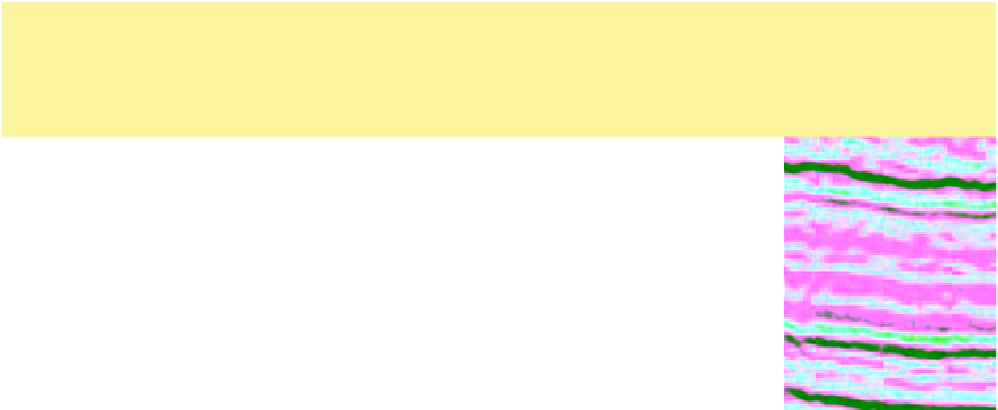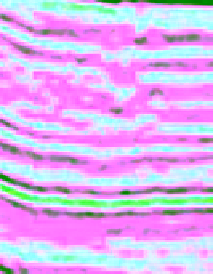Geoscience Reference
In-Depth Information
modified locally in many areas by structural
inversion resulting from NNE-SSW oriented com-
pression during the Santonian to late Maastrichtian
(Cartwright, 1989; Vejbæk & Andersen, 2002).
Exact timing of the compressional movements
probably differs from one tectonic lineament to
another. Inversion occurred primarily along major
reactivated extensional faults generating anticli-
nal fold structures such as the Lindesnes Ridge
(Bramwell
et al
., 1999). The inversion areas
commonly developed shallow extensional faults
on their flanks and crests as they grew. Such
structures became unstable and collapsed due to
gravity (e.g. Farmer & Barkved, 1999). Seismic
data show that inversion structures were also
subject to erosion, particularly during deposition
of the Tor Formation (Farmer & Barkved, 1999;
Sikora
et al
., 1999).
Influence of tectonics on deposition
Depositional models for the Chalk Group published
during the 1970s to 1980s tended to divide the chalk
sedimentary facies into autochthonous and alloch-
thonous types (Kennedy, 1987b). Autochthonous
chalk is a result of pelagic sedimentation and trace
fossils such as
Planolites
,
Chondrites
,
Zoophycos
and
Thalassinoides
are common (Ekdale & Bromley,
1991). Hiatus horizons and intervals representing
low sedimentation rate are expressed by nodular
chalk, firmgrounds and hardgrounds (Bromley &
Ekdale, 1986; Bromley, 1996).
Allochthonous chalk is a result of re-sedimenta-
tion by gravitational processes. The most common
cause of chalk re-sedimentation was slope failure
due to syndepositional tectonism. Likely tectonic
mechanisms include development of growth-fold
Stratigraphy
JCR
Nanno
Zone
Sea-level
curve
Lithostratigraphy
Stages
Norway
Seismostratigraphic
units in this study
Series
75
50
25
0
-25 m
.
61.1Ma.
NNTp5
NT4
NNTp3
NNTp4
NT3
Ekofisk Fm
Danian
NNT2
NNTp2
NT1
NNTp1
65.5
UC20
UC20
UC19
UC19
Maastrichtian
Tor Fm
UC18
UC18
UC17
UC17
70.6
UC1 6
UC16
UC1 5
UC15
Magne Fm
Campanian
UC14
UC14
UC13
Thud Fm
83.5
UC13
UC12
Santonian
UC12
UC11
85.8
UC11
Coniacian
UC0
UC10
Narve Fm
88.6
UC9
UC9
Turonian
U8
UC8
U
UC7
U 6
UC6
93.6
Blodøks Fm
UC4&5
UC4 &5
UC1
UC3
UC3
U2
UC2
Cenomanian
Hidra Fm
UC1
UC1
99.6
Fig. 2.
Lithostratigraphy of the Chalk Group in the Danish sector and southern Norwegian sector of the North Sea and the
corresponding seismostratigraphic units used in this study. JCR = Joint Chalk Research Phase V (Bailey
et al
., 1999). Ages
after Gradstein
et al
. (2005) and Ogg
et al
. (2008) and eustatic sea-level curve from Kominz
et al
. (2008). The sea-level
estimate of Kominz
et al
. (2008) is the most detailed and updated for the stratigraphic interval of interest in this study and
was chosen to evaluate the possible influence of sea-level on the deposition of chalk.
































































Search WWH ::

Custom Search